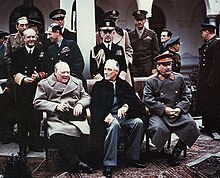We should look at history ! Now
Dr. Strangelove or: How I Learned to Stop Worrying and Love the Paradox on U Tube
Cold War
The Cold War was the tense relationship between the United States (and its allies), and the Soviet Union (the USSR and its allies) between the end of World War II and the fall of the Soviet Union.[1][2] It is called the "Cold" War because the US and the USSR never actually fought each other directly. Instead, they opposed each other in conflicts known as proxy wars, where each country chose a side to support.
Contents
Conflicting countries[change | change source]
Most of the countries on one side were allied in NATO whose most powerful country was the United States. Most of the countries on the other side were allied in the Warsaw Pact whose most powerful country was the Soviet Union.[3]
The Western Bloc was the name of the capitalist countries led by the United States. The North Atlantic Treaty Organization (NATO) is an alliance created in 1949 which included the US, United Kingdom, France, West Germany, Canada, Netherlands, Belgium, Luxembourg, Spain, Portugal, Italy, Norway, Iceland, Denmark, Greece, and Turkey. Other countries allied with the Western Bloc include Israel, Japan, South Korea, Thailand, Iran (1945-1979), Pakistan, Malaysia, Philippines, South Africa, Australia and New Zealand.
The Eastern Bloc was the group of socialist countries led by the Soviet Union (USSR). The Warsaw Pact was an alliance created in 1955 which included the USSR, Albania, Bulgaria, Czechoslovakia, East Germany, Hungary, Poland, and Romania. Other countries allied with the Eastern Bloc included Angola, Ethiopia, Cuba (1959-1991), Mongolia, North Korea, China (1948-1966) and Vietnam.
Background[change | change source]
In February 1917, Tsar (King) Nicholas II of the Russian Empire was overthrown because people were unhappy with their living conditions, especially during World War I. The new government in Russia was a democratic socialist government. Unfortunately, it was ineffective, and people were still unhappy. In November 1917, a communist group called the Bolsheviks led by Vladimir Lenin overthrew the new government. They were supported by groups of workers called Soviets. The Bolsheviks created a new communist government called the Russian Soviet Federative Socialist Republic (called simply Soviet Russia or the Russian SFSR).
However, not everyone supported the communists. Many countries that had been a part of the Russian Empire had left, such as Latvia, Lithuania, Estonia, Poland, and Finland. The Russian Civil War began, with the Russian SFSR's "Red Army" fighting against the "White Army", the group of all Russians against the communists. The White Army was not very united or organized. The Allied Powers of World War I, such as the United States, United Kingdom, and France, invaded Russia to support the White Army. Soviet Russia eventually won the war in 1922, and established the Union of Soviet Socialist Republics (Soviet Union), along with the newly formed Soviet Socialist Republics of Ukraine, Belarus, Armenia, Azerbaijan and Georgia.
The start of the Cold War in 1947 was due to a belief that all governments would become either communist or capitalist. The Western allies feared that the Soviet Union would use force to expand its influence in Europe, and was especially concerned that Soviet agents had obtained information on making the Atom Bomb after the war.
Both groups of nations had opposed Nazi Germany. The Soviet Union had sporadically co-operated with Germany and shared in the division of Poland in 1939, but Germany turned against the Soviet Union in June 1941 with Operation Barbarossa.
After World War II[change | change source]
After WWII, Germany was left in ruins. The victorious Allies that occupied it split it into four parts. In the western half of Germany, one part was given to the United States, one to the United Kingdom, and one to France. The Eastern half was occupied by the USSR. The city of Berlin was also split among the four countries, even though it was entirely within the Eastern half.
The Federal Republic of Germany (Bundesrepublik Deutschland or BRD), or West Germany, was recognized by the Western allies in June 1949. It was a capitalist democracy. West Berlin was considered a part of the country. The USSR named their section of Germany the German Democratic Republic (Deutsche Demokratische Republik or DDR), or East Germany, later in 1949. It was a communist dictatorship.
From April 1948 to May 1949, the Soviets blockaded West Berlin to prevent the city from using West Germany's currency. The United States and its allies supplied the city through airplanes until September 1949 in what became known as the Berlin Airlift. Many East Germans wanted to live in West Germany due to its greater quality of life and political freedoms. Thus, in 1961, the East German government built the Berlin Wall, dividing the two halves of the city. It was heavily guarded to prevent people from escaping to the West. It was considered a symbol of the Cold War and the Iron Curtain that divided Europe.



Comments
Post a Comment